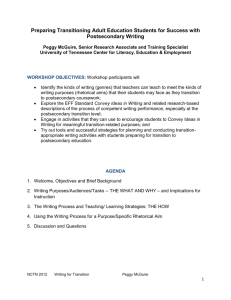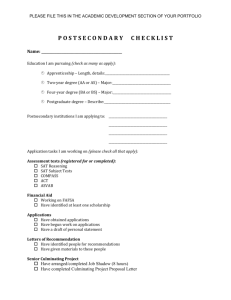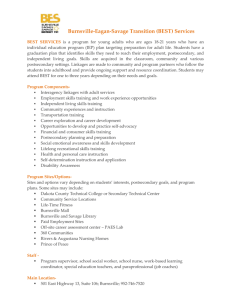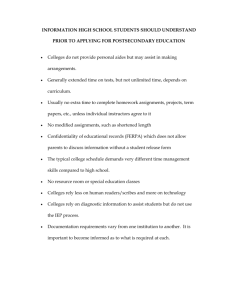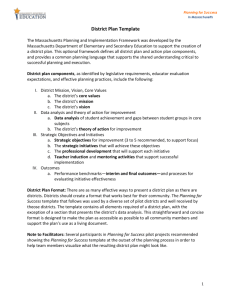Next Steps/Comments
advertisement
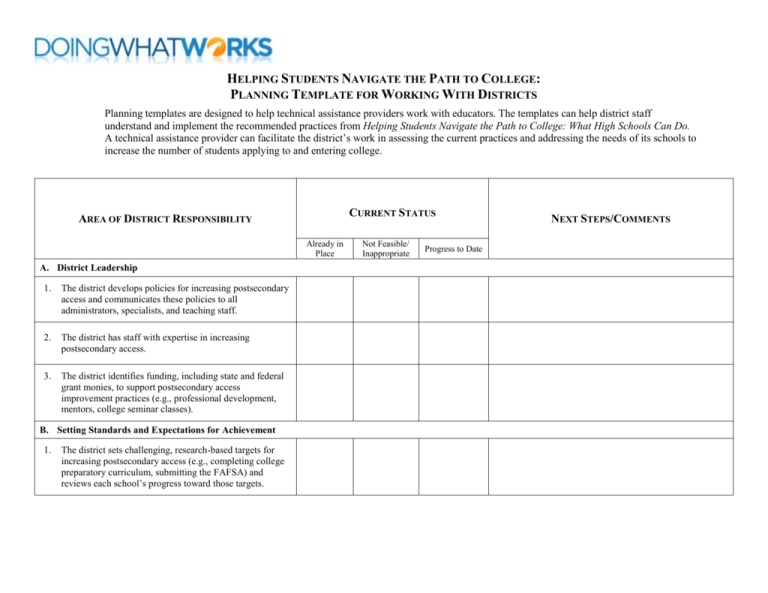
HELPING STUDENTS NAVIGATE THE PATH TO COLLEGE: PLANNING TEMPLATE FOR WORKING WITH DISTRICTS Planning templates are designed to help technical assistance providers work with educators. The templates can help district staff understand and implement the recommended practices from Helping Students Navigate the Path to College: What High Schools Can Do. A technical assistance provider can facilitate the district’s work in assessing the current practices and addressing the needs of its schools to increase the number of students applying to and entering college. CURRENT STATUS AREA OF DISTRICT RESPONSIBILITY Already in Place A. District Leadership 1. The district develops policies for increasing postsecondary access and communicates these policies to all administrators, specialists, and teaching staff. 2. The district has staff with expertise in increasing postsecondary access. 3. The district identifies funding, including state and federal grant monies, to support postsecondary access improvement practices (e.g., professional development, mentors, college seminar classes). B. Setting Standards and Expectations for Achievement 1. The district sets challenging, research-based targets for increasing postsecondary access (e.g., completing college preparatory curriculum, submitting the FAFSA) and reviews each school’s progress toward those targets. Not Feasible/ Inappropriate Progress to Date NEXT STEPS/COMMENTS Helping Students Navigate the Path to College: Planning Template for Working With Districts CURRENT STATUS AREA OF DISTRICT RESPONSIBILITY Already in Place 2. The district sets high expectations for all students’ achievement, even those not traditionally expected to attend college, and measures each school’s results against these expectations. C. Providing Research-Based and Effective Instruction in Support of State and District Standards 1. The district provides evidence of academic support program impacts (e.g., increased academic achievement or more rigorous course-taking). 2. The district provides evidence of college-planning program impacts (e.g., more students taking college entrance exams and/or completing admissions applications). 3. The district provides research-based guidance on fostering college aspirations. 4. The district provides research-based guidance on identifying and implementing a college-ready curriculum. 5. The district supports schools in using regular assessments to keep students informed of their level of college preparation. 6. The district supports schools in using assessments to help students strengthen their college readiness. Not Feasible/ Inappropriate Progress to Date NEXT STEPS/COMMENTS Helping Students Navigate the Path to College: Planning Template for Working With Districts CURRENT STATUS AREA OF DISTRICT RESPONSIBILITY Already in Place 7. The district identifies resources schools can use to engage students in college preparation, especially traditionally underserved students. 8. The district supports schools in establishing academic- and college-planning programs to assist students in preparing for college. D. Recruiting, Retaining, Supporting High-Quality Staff 1. The district helps schools recruit and train mentors to meet the needs of high schools, especially those that, historically, have not sent many students to college. 2. The district provides incentives to draw and retain highly qualified teachers for its schools with low performance related to preparing students for college. 3. The district provides teachers and counselors with professional development to expand knowledge and skills in promoting postsecondary access. 4. The district provides supervisory training to principals and teacher leaders who support teachers in providing a rigorous course of study and ensuring students understand the steps toward college enrollment. 5. The district provides schools with counselors trained in college advising. Not Feasible/ Inappropriate Progress to Date NEXT STEPS/COMMENTS Helping Students Navigate the Path to College: Planning Template for Working With Districts CURRENT STATUS AREA OF DISTRICT RESPONSIBILITY Already in Place E. Using Data for Planning and Accountability 1. The district utilizes longitudinal student-level data that monitors college-readiness predictors and links students to teachers. 2. The district provides school staff with training on using data to identify students at risk of not being academically prepared for college. 3. The district works with each school to ensure they implement regular analysis of college-readiness data and effective strategies to work with at-risk students. F. Promoting Equity/Adequacy of Fiscal and Human Resources 1. The district reviews the progress and needs of each school annually and identifies the additional staff resources necessary to promote college access. 2. School progress and needs are considered in distribution of state and federal funds for school improvement. 3. Schools with demonstrated commitment to increasing students’ postsecondary access have equitable access to these funds. G. Engaging Families and Community 1. The district communicates with families and the community regarding the policies for working with students whose are not mastering a college-ready curriculum. Not Feasible/ Inappropriate Progress to Date NEXT STEPS/COMMENTS Helping Students Navigate the Path to College: Planning Template for Working With Districts CURRENT STATUS AREA OF DISTRICT RESPONSIBILITY Already in Place 2. The district has partnered with community-based program providers and other agencies to implement programs that promote college readiness. 3. The district has recruited mentors from community agencies, businesses, and colleges and universities. 4. The district has partnered with colleges to provide activities that support a college-going culture (e.g., campus visits). Not Feasible/ Inappropriate NEXT STEPS/COMMENTS Progress to Date This project has been funded at least in part with Federal funds from the U.S. Department of Education under contract number ED-PEP-11-C-0068. The content of this publication does not necessarily reflect the views or policies of the U.S. Department of Education nor does mention of trade names, commercial products, or organizations imply endorsement by the U.S. Government.

